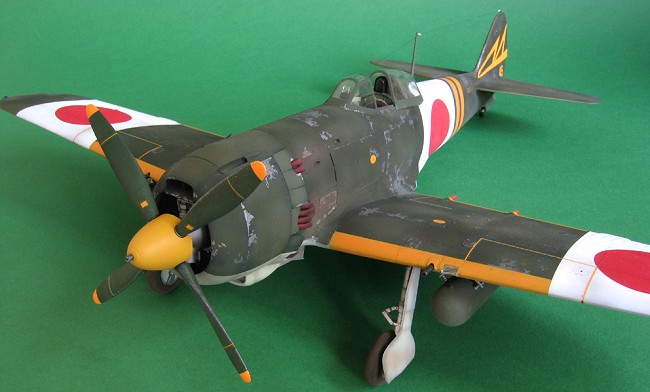
Hasegawa 1/32 Ki-84 Hayate (Frank)
| KIT: | Hasegawa 1/32 Ki-84 Hayate (Frank) |
| KIT #: | 08074 |
| PRICE: | £24.95 |
| DECALS: | See Review |
| REVIEWER: | Steve Budd |
| NOTES: |

| HISTORY |
Please see Tom Cleaver’s Ki-84 article for a comprehensive history of the Frank.
| THE KIT |
Ten sprues plus some poly caps lurk in the box. All are produced to the most modern standard and if you’re not seized by a compulsive and irresistible urge to start nailing them together immediately you are guaranteed to be either dead, an armour modeller or my wife (who would rather eat raw slugs, two at a time).
| CONSTRUCTION |
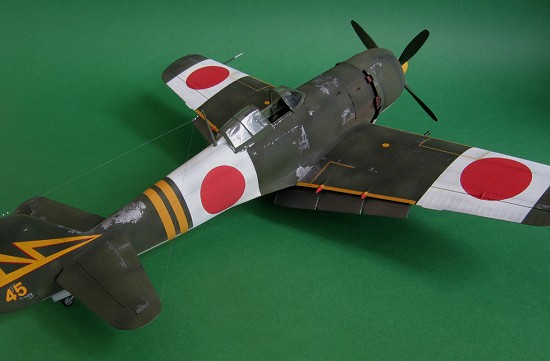 Be cautioned that I
can make even Tamiya kits challenging at times (it’s an innate gift). With
that disclaimer protecting me from prosecution from hordes of angry plastic
bashers around the globe here are the bits I’ll pay more attention to when
I hustle the next one together:
Be cautioned that I
can make even Tamiya kits challenging at times (it’s an innate gift). With
that disclaimer protecting me from prosecution from hordes of angry plastic
bashers around the globe here are the bits I’ll pay more attention to when
I hustle the next one together:
The instrument panel – Part number A14 has a single decal for the dials. I struggled to get the whole lot to line up and succeeded only after much persistence and a bath tub full of Daco’s ‘Strong’ decal softener. Next time I’ll scalpel the upper ten dials from the wider lower section and sort them separately.
The engine assembly – Section 7 of the instructions is the bit that refers. I confidently relied on foolproof engineering to ensure my prop sat square in relation to the cowling when the time came to add it towards the end of the build. It didn’t and mocked me ruthlessly with a slight downward attitude that suggested its personality had become decidedly introverted. The only realistic option for removing the engine was via a 2.5 pound club hammer and as use of such a tool was likely to ‘mar the finish’ I went with the soft alternative of gently bending the prop shaft upwards which restored my expression to that of a Buddhist monk in a perfect state of Nirvana.
The flaps – Parts numbered A23 and A24. These are very lovely but for the ejection pin marks that are (yes, you’ve guessed it) on the side that’s going to need a natural metal finish. Careful photography has concealed my less than perfect achievements in this constructional chapter. Beyond this, the flaps have attachment pins that appear smaller than the pimples on a flea’s backside (not that I’ve studied many flea butts…) and so need larger and deeper attachment holes on the wings and wire pins on the flaps themselves. With this modification you increase the chances of the flaps surviving any accidental knocks during handling.
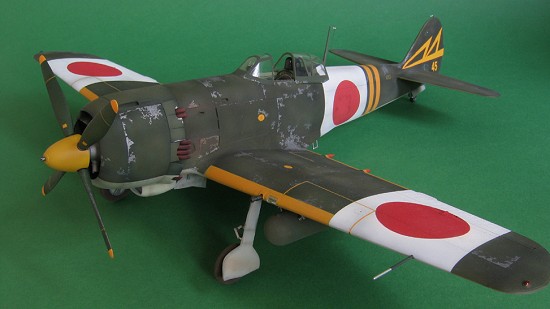 The antenna mast
– This was left off until the end to make painting the white home defence
band more straightforward. I drilled the top (not right through) to accept
the one pound fishing line that’d be used for the aerial wire a little
later. I carefully applied five minute epoxy inside the mast hole for
strength and to provide a little time for aligning the thing before
‘setting up’. All seemed well. The wire from the mast to the tail was run
in with a little tension to keep it tight. Before joining, a couple of
sections of light filament (about 2mm long) were threaded on to represent
spring tensioners. The first was super glued immediately behind the mast
with the second about 4-5mm back. The second wire adjoins the starboard
stabiliser near its tip to a point about 5mm back from the mast (i.e. just
in front of the rear tensioner). The tension from this wire pulled the
first a little to the right. The third wire routes from the same point
behind the mast to an insulator on the fuselage immediately below but to
the right. With a third lot of tension now in play the mast was taking on a
rather drunken lean and I was (again) amazing myself with a penchant for
creating terminal problems on the final lap of nearly every build. Not
nearly enough epoxy. Oh dear.
The antenna mast
– This was left off until the end to make painting the white home defence
band more straightforward. I drilled the top (not right through) to accept
the one pound fishing line that’d be used for the aerial wire a little
later. I carefully applied five minute epoxy inside the mast hole for
strength and to provide a little time for aligning the thing before
‘setting up’. All seemed well. The wire from the mast to the tail was run
in with a little tension to keep it tight. Before joining, a couple of
sections of light filament (about 2mm long) were threaded on to represent
spring tensioners. The first was super glued immediately behind the mast
with the second about 4-5mm back. The second wire adjoins the starboard
stabiliser near its tip to a point about 5mm back from the mast (i.e. just
in front of the rear tensioner). The tension from this wire pulled the
first a little to the right. The third wire routes from the same point
behind the mast to an insulator on the fuselage immediately below but to
the right. With a third lot of tension now in play the mast was taking on a
rather drunken lean and I was (again) amazing myself with a penchant for
creating terminal problems on the final lap of nearly every build. Not
nearly enough epoxy. Oh dear.
I sat and pondered. My first inclination was to snip the whole lot off, pull out the mast and weld, glue, nail and screw the thing in place. That sadly quieter voice spoke to me from the farther recesses of my consciousness (my wife calls it ‘reason’) and suggested I do the unthinkable – take hold of the mast and bend it firmly away from the direction of drag so as to stretch but not break the monofilament to the point where it was taught but not tight (if you follow my drift). Remember this was one pound line. Heart in mouth I manipulated the tiny plastic fishing rod in the ridiculous hope this half-baked plan would save me from a mini re-build. Know what – it did. I was (and still am) seized with disbelief that it worked but the evidence is in the photographs.
Canopy parts – I bought the Eduard kabuki tape pre-cut mask set but found it didn’t fit as easily or as well as I’d hoped. This was quickly junked for my preferred method of Parafilm M and a sharp scalpel.
| COLORS & MARKINGS |
The decal option that lured me was the one on the box exterior – a Frank from the 47th Flight Regiment, 3rd Squadron, Narimasu Airfield in February 1945.
Despite Tom Cleaver’s assurances that the kit decals looked better than previous sheets issued by Hasagawa I figured I’d still opt for masks for all the markings bar the tail, wing walkways and fuel caps.
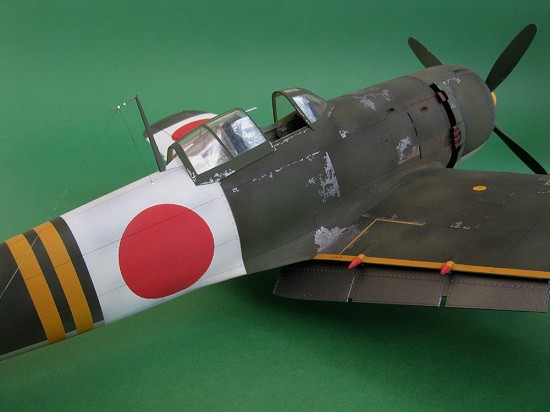 The paint fest began
with an overall prime with Tamiya Deck Tan. Build glitches were apparent
and sorted with My Surfacer 500. The green camo was next up with a base
coat of Tamiya Japanese Army Green. Beyond this I hurled authenticity out
of the modelling shed door and accumulated most of my Tamiya green paint
shades. These were diluted to around 30% paint to 70% thinner and traced
over the base in streaks, patches and other sundry shapes while maintaining
a carefree ‘yippee’ attitude to the whole thing.
The paint fest began
with an overall prime with Tamiya Deck Tan. Build glitches were apparent
and sorted with My Surfacer 500. The green camo was next up with a base
coat of Tamiya Japanese Army Green. Beyond this I hurled authenticity out
of the modelling shed door and accumulated most of my Tamiya green paint
shades. These were diluted to around 30% paint to 70% thinner and traced
over the base in streaks, patches and other sundry shapes while maintaining
a carefree ‘yippee’ attitude to the whole thing.
I had, over several years, carefully nurtured a bottle of Aero Master Japanese Army Green, which was noticeably lighter than the Tamiya base colour. This was used in a thinned over spray to highlight various parts fairly randomly (rather than a robotic ‘centre of every single panel’ approach).
Now happy with the top my Frank performed a perfect roll to starboard to wantonly accept paint on her nether regions. Tamiya Japanese Army Grey was first up followed by Aero Master’s enamel version of the same colour, this time misted on to give a toned effect. Post shading was run in via Tamiya acrylic thinner with a few drops of Nato Black and Red Brown in it to give a dirty mix. This was easy to apply and control at only 10psi, so much so that I ‘drew’ the panel lines in the mix which darkened as the spray collected in the grooves while leaving delicate shading either side. Joy!
The white home defence bands were masked off, first the edges courtesy of 3M plastic tape (about 3mm wide), then with ordinary low tack tape and Parafilm M taking care of the areas further out. The white was misted on and built up in patches leaving the pre-shaded look evident.
The hinomaru were sorted with masks made with a compass cutter. I had a little bleed under which was solved by applying the round section previously cut out of the mask over the red. White was misted on until all was well. However, a solution for avoiding bleed under in the first place was found on the web as so often happens – a week after the event! All you do is apply said mask and burnish down the edges. Spray gloss varnish over the exposed portion of the mask and over the edges (while obviously avoiding creating a built up edge). This seals the edges and any bleed under is clear and won’t show (after it’s matted down). Lastly apply colour in the usual way and presto – sharp sprayed edges.
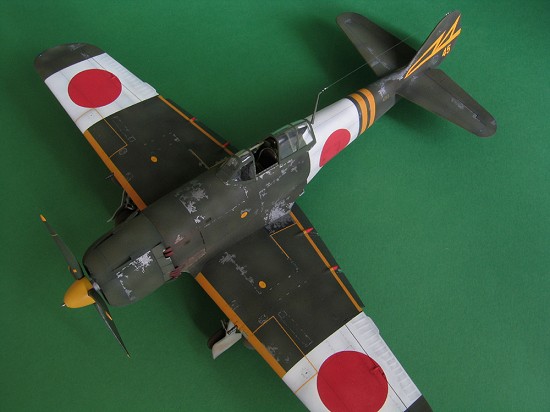 The yellow wing ID,
trailing edge lines and fuselage bands were masked using the same materials
and once in place the existing colour was over sprayed with a Tamiya light
grey (can’t remember which one) to eliminate the contrast between the upper
green and lower grey and give an even base for the yellow. The yellow
itself was custom mixed from Tamiya flat yellow with a little red added to
bring its tone closer to the decidedly orange yellow hue of the tail
decals.
The yellow wing ID,
trailing edge lines and fuselage bands were masked using the same materials
and once in place the existing colour was over sprayed with a Tamiya light
grey (can’t remember which one) to eliminate the contrast between the upper
green and lower grey and give an even base for the yellow. The yellow
itself was custom mixed from Tamiya flat yellow with a little red added to
bring its tone closer to the decidedly orange yellow hue of the tail
decals.
Speaking of tail decals, I kicked off this stage by confidently removing the double triangular marking for the port fin side and promptly folded it over on itself while tearing it for good measure – all achieved during a journey of about an inch from backing paper to model. Terminally wrecked I thought ‘No problem – I’ll retrieve the sheet from my second kit and use the port fin flash from that’. Even in the fluorescent loft light it was apparent that the second sheet was a wildly different shade of yellow (recalling my careful efforts at matching the tone of sheet one).
Adapting again to catastrophe I crossed fingers and relied on blind hope that leaving off the white underlay marking on the port side would dull the yellow down enough to pass muster. The tonal issue made use of the port ‘45’ from sheet two compulsory so this was snaffled too. Sundry walk lines were added (and these required very careful application too) and bedded in with more ‘Strong’ Daco softener.
I was going to go with a satin finish but went matt at the last minute. Paint chips were applied with nothing more complex than Xtracolour Gunmetal and a fine brush. The key here is to build it up slowly over several sessions using the most mystical intuitive feel you can muster while avoiding any even or rhythmic patterns. With this bit sorted it was over sprayed with a little more matt varnish to seal it and the beastie was ready for the flight line.
| CONCLUSIONS |
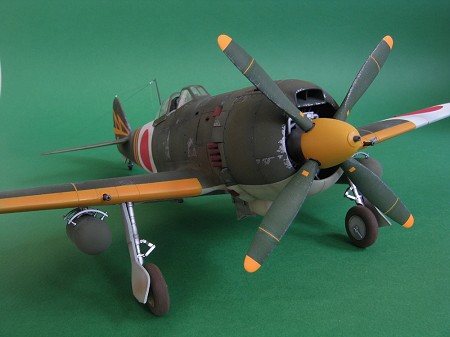 I learned
important new lessons from this build. That’s not a criticism of the kit –
it’s as perfect as a modern model gets. What I mean is, there’s an
expression ‘shake n bake’ that implies there are no pitfalls for the
regularly unwary (me). Stay switched on and the potential problems are
minor and eminently avoidable.
I learned
important new lessons from this build. That’s not a criticism of the kit –
it’s as perfect as a modern model gets. What I mean is, there’s an
expression ‘shake n bake’ that implies there are no pitfalls for the
regularly unwary (me). Stay switched on and the potential problems are
minor and eminently avoidable.
I loved it and the greatest test lies in the fact that I enjoy looking at it every time I’m installed in the shed. It has presence – I hope to get the second one built before God reels me in.
November 2005
If you would like your product reviewed fairly and quickly, please contact me or see other details in the Note to Contributors.